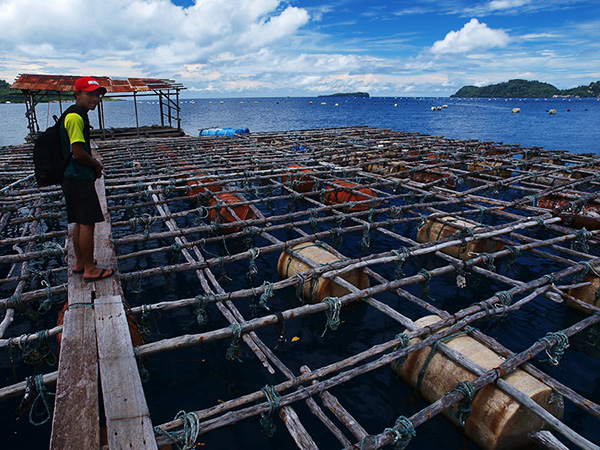Pulau Banda Besar, also known as Pulau Lonthor – named after the largest village on the island – is one of the three main islands in the Banda archipelago and is the largest of the three. Although it’s not as famous as its neighbour, Banda Neira, Banda Besar is actually a host of lots of interesting things and places to visit, with not less interesting history compared to the neighboring island. Today, the six of us – Ela, Hadi, Ehsan, Reza, Victor and I – accompanied by Pak Anwar our guide during this Banda trip. The hardcore diver group – Nia, Erika, Koh Aliong & Madon – elected to stick to their dive plan. Juergen & Kathy, our new friends from Germany that were also staying at Hotel Maulana, were also interested with our plan and eventually joined us, going across from Banda Neira to explore the Lonthoir island, home of about 2000 inhabitants..
The journey began from Banda Neira local harbor, where we rented a pok-pok – a boat with an outboard engine used by local people as transportation between the islands in the archipelago – at the rate of IDR 75,000. Of the nine of us, only Ela and I chose to sit inside the pok-pok, while others confidently chose and sit on the pok-pok roof, dare to challenge the morning sun that was shining brightly. The water was very clear, that in some shallow parts we could easily see the healthy coral reefs in the water. It was an incredible view, and it was very encouraging to know that coral reefs in this area have been growing and living healthy. Less than half an hour, we were already approaching the pier of Lonthoir village. Lonthoir beach panorama was the first thing that we enjoy in this island, made us stop for a while before moving toward Lonthoir village, located on the hills..
Along the village road, we could see the spices drained by a simple way – left dried under the sun- before being further processed. The same precious spices that were once became the reason of those European nations sailing across the sea in a quest to look for the source of the spices. Nutmeg, walnuts, cinnamon, were left dried on the stretch of cloth or plastic in front of the villager’s houses.
Walking towards Lonthoir Atas, we had to climb hundreds of steps that are quite steep. According to Pak Anwar, the total number of steps is around 350 steps. Thankfully, we did not need to climb up to the top end, as in the middle of the way we turned right toward the perigi (well) that was considered sacred by the local people.
There are two wells (perigi) at Bukit Kele, Lonthoir village. But only one of them is cosidered sacred by the local villagers. Every 15-20 years, they hold a “Cuci Perigi” ceremony to commemorate the death of 33 Imams (the priests) when VOC came and colonized these islands. The spirit of the 33 Imams will then be ‘removed’ from the well using 99 depa (a local measure) of white cloth to clean the well. The white cloth is meant to simbolically wrap the bodies of the 33 Imams in accordance with Muslim burial traditions.
Off from the sacred well complex, we continued to trek accross the island through several villages to the location of the fort Hollandia. Well, the remains of fort Hollandia, to be precise. On the way to the fort Hollandia’s location, we were through a big stone that was name by the local people “Batu Berdarah” (the bloody stone). The old story tells that VOC representatives and the kings of Banda Besar once made a deal back then, and to tie the agreement they sliced each other’s fingers on top of this big rock.
What is left of the fort Hollandia is just one of the fortress walls with its gate. Not much to see from the remains of the fort. However, from the thickness of the wall we can imagine how big and strong this fortress once was. The view from the fort is fabulous. In front of us, Gunung Api stands gallantly. The blackened remnants of molten lava from the last eruption in the late of 1980s is obvious from here. While the houses of Lonthoir Bawah village lining at the bottom of the hill on which the fort was once stood.
The trekking resumed down the hill towards Lonthoir Bawah, and then heading to the east to visit the pearl farm. At Lonthoir Bawah, we stopped at a ‘warung’ to enjoy nutmeg syrup and walnut cake. The fresh nutmeg syrup with ice, was very helpful to bring back the spirit to continue trekking in such a hot day. Fortunately, the track from Lonthoir Bawah to the pearl farm was through a shady nutmeg plantation, where thousands of hundreds of years old nutmeg trees were scattered arround. Very helpful to protect us from the stinging sun. One interesting thing I got from Pak Anwar: where there are nutmeg trees, there must be walnut trees. Apparently, the tall and shady walnut trees also serve as the protector for the shorter nutmeg trees from the direct sunlight.
It was getting late in the afternoon, and we were getting tired as well after walking under the stinging sun for almost the whole day. The initial intention to visit fort Concordia in the eastern part of the island was cancelled, much to the relieve of all parties. Hopefully we will have a chance to return to Banda, with a longer time span of course, so we can complete our exploration throughout this beautiful archipelago that also has lots of historical story along with its beauty..
- Photos from Banda trip are stored at http://www.ismawanismail.com/gallery/index.php?/category/banda
- Some information in this article were taken from www.tourismmaluku.org





keren…
makasih..makasih.. 🙂